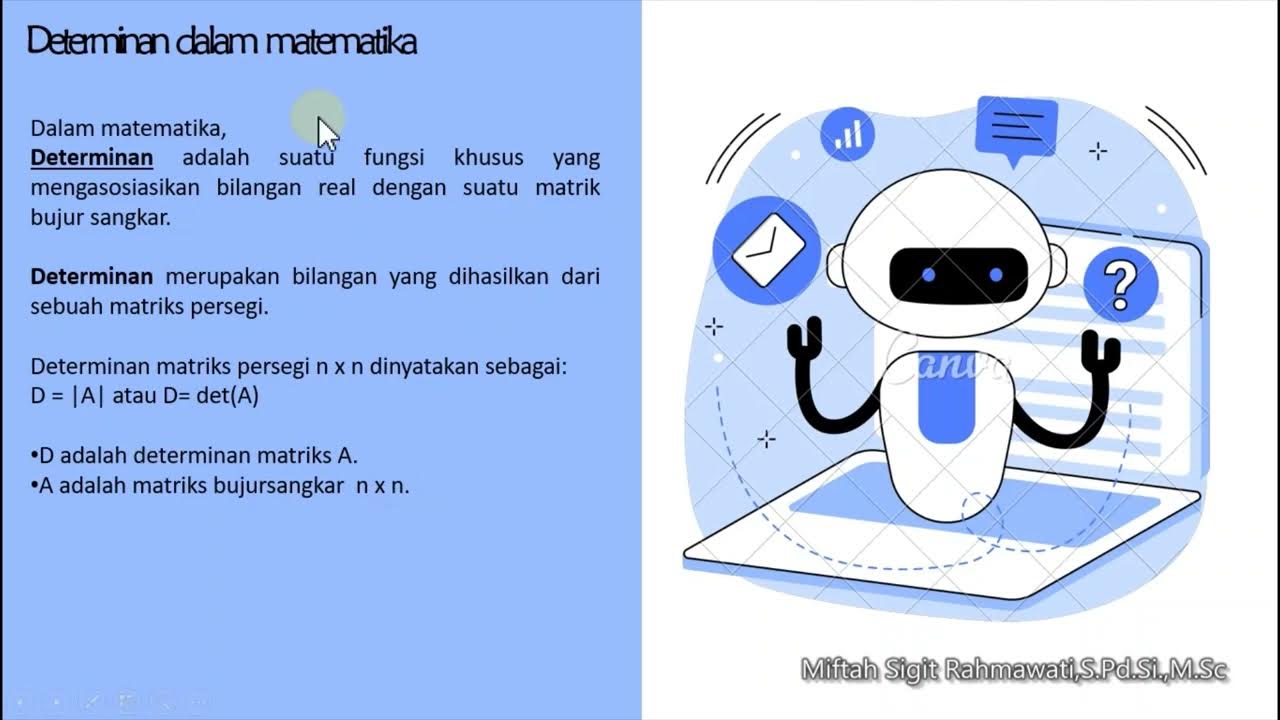The Applications of Matrices | What I wish my teachers told me way earlier
Summary
TLDRThis video delves into the extensive applications of matrices in various fields, from electronics and image processing to computer graphics and network analysis. It explains how matrices can transform vectors, crucial for understanding systems in linear algebra. The script covers real-world uses such as solving complex systems of equations, analyzing population dynamics, and even aiding in criminal investigations through image enhancement. It also touches on the use of matrices in Google's PageRank algorithm, encryption methods, and their foundational role in machine learning and neural networks, demonstrating the profound impact of matrices in technology and security.
Takeaways
- 📚 Matrices are fundamental in various fields such as circuit analysis, image processing, quantum mechanics, and computer graphics.
- 🧩 Initially, matrices may seem boring due to their basic operations like addition and multiplication, which lack immediate context or excitement.
- 🔍 Matrix multiplication with a vector can transform the vector through scaling and rotation, which is a key concept in linear algebra.
- 🌀 Special matrices like the identity matrix only rotate vectors, while others may only scale them, with eigenvectors being unaffected by rotation.
- 🔑 Matrices are used to solve systems of linear equations, where the coefficients and variables are organized into matrices for easier computation.
- 🦠 The script uses a hypothetical zombie outbreak scenario to illustrate how matrices can model and predict the dynamics of a system over time.
- 🔍 Image processing involves manipulating pixel values in an image, represented as matrices, to apply effects like blurring, sharpening, or edge detection.
- 🌐 The adjacency matrix in graph theory represents connections between nodes and can be used to analyze complex networks like social connections or the web.
- 🔑 The power of an adjacency matrix can reveal paths of different lengths between nodes, and the trace of the matrix cube can indicate the presence of triangles in a network.
- 🤖 Applications of matrices extend to machine learning and neural networks, where they are crucial for the training and operation of algorithms.
- 🔒 Historically, matrices have been used in encryption methods like the hill cipher, demonstrating their role in security.
Q & A
What are some fields where matrices are extremely important for understanding or analyzing different systems?
-Matrices are used in fields such as image processing, computer graphics, quantum mechanics, the Google PageRank algorithm, and network analysis.
How do matrices transform vectors?
-Matrices can scale and rotate vectors. When a vector is multiplied by a matrix, the resulting vector is a transformation of the original vector according to the matrix's properties.
What is an eigenvector and eigenvalue?
-An eigenvector is a vector that, when multiplied by a matrix, only changes scale and not direction. The factor by which the vector is scaled is known as the eigenvalue.
How do matrices help solve systems of equations?
-Matrices can be used to represent the coefficients and variables in a system of equations. By applying matrix multiplication, one can find the solution to the system, which corresponds to the input vector that results in a given output vector.
What is a Markov matrix and how is it used?
-A Markov matrix is a matrix where each column sums to 1 and contains no negative values, representing probabilities of transitioning from one state to another. It's used to model systems that evolve over time, such as population dynamics.
How can matrices be used to analyze a zombie outbreak scenario?
-In a zombie outbreak scenario, matrices can model the dynamics of human and zombie populations over time by representing the rates of infection and cure. By applying matrix multiplication iteratively, one can predict the long-term outcomes of the outbreak.
What is the Google PageRank algorithm and how does it relate to matrices?
-The Google PageRank algorithm uses Markov matrices to rank websites. It treats outgoing links as probabilities of transitioning from one site to another, influencing the site's ranking based on the 'importance' of the sites it links to.
How are matrices used in image processing to blur an image?
-In image processing, matrices can be used to blur an image by applying a kernel matrix over the image matrix. Each pixel in the resulting image is a weighted average of the pixels under the kernel, which smooths transitions between different colors.
How did law enforcement use matrices to identify an attacker in the Reginald Denny case?
-In the Reginald Denny case, law enforcement used image processing techniques involving matrices to enhance the quality of live footage and identify a distinctive tattoo, which helped in securing a conviction.
What is an adjacency matrix and how is it used in network analysis?
-An adjacency matrix is a matrix that represents a graph, where each row and column corresponds to a node, and the entries indicate the presence or absence of a connection between nodes. It's used to analyze networks by counting paths of different lengths between nodes.
How do matrices contribute to the field of machine learning and neural networks?
-Matrices are fundamental in machine learning and neural networks for coding and manipulating data. They allow for efficient computation of linear transformations, which are essential operations in training and applying machine learning models.
Outlines

This section is available to paid users only. Please upgrade to access this part.
Upgrade NowMindmap

This section is available to paid users only. Please upgrade to access this part.
Upgrade NowKeywords

This section is available to paid users only. Please upgrade to access this part.
Upgrade NowHighlights

This section is available to paid users only. Please upgrade to access this part.
Upgrade NowTranscripts

This section is available to paid users only. Please upgrade to access this part.
Upgrade Now5.0 / 5 (0 votes)





